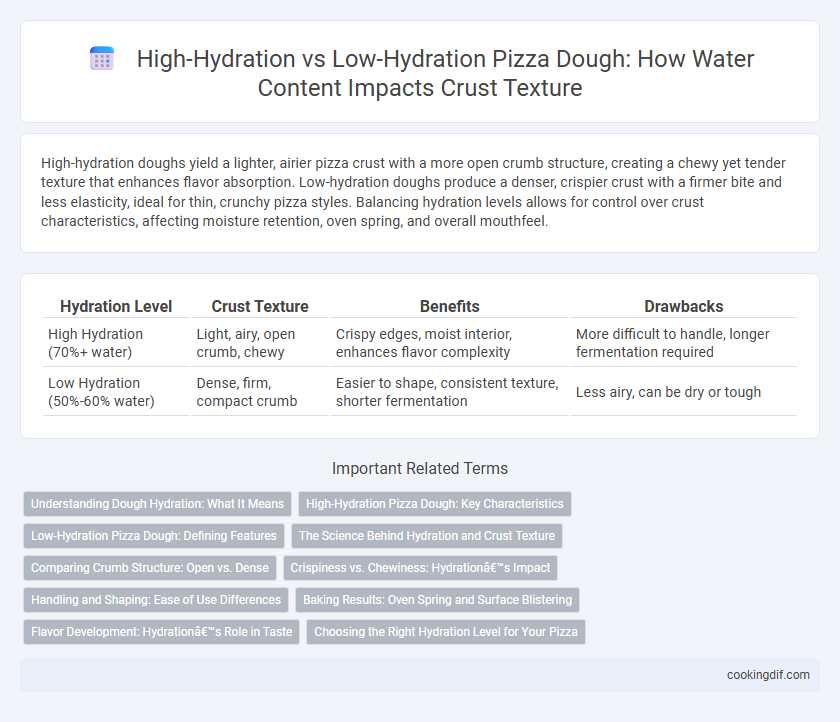High-hydration doughs yield a lighter, airier pizza crust with a more open crumb structure, creating a chewy yet tender texture that enhances flavor absorption. Low-hydration doughs produce a denser, crispier crust with a firmer bite and less elasticity, ideal for thin, crunchy pizza styles. Balancing hydration levels allows for control over crust characteristics, affecting moisture retention, oven spring, and overall mouthfeel.
Table of Comparison
| Hydration Level | Crust Texture | Benefits | Drawbacks |
|---|---|---|---|
| High Hydration (70%+ water) | Light, airy, open crumb, chewy | Crispy edges, moist interior, enhances flavor complexity | More difficult to handle, longer fermentation required |
| Low Hydration (50%-60% water) | Dense, firm, compact crumb | Easier to shape, consistent texture, shorter fermentation | Less airy, can be dry or tough |
Understanding Dough Hydration: What It Means
Dough hydration refers to the ratio of water to flour, typically expressed as a percentage, which directly influences pizza crust texture and elasticity. High-hydration doughs, with water content above 70%, produce airy, open crumb structures and a softer, chewier crust due to increased gluten development and steam formation during baking. In contrast, low-hydration doughs around 50-60% water yield denser, crisper crusts that are easier to shape and handle, favored for traditional Neapolitan or New York-style pizzas.
High-Hydration Pizza Dough: Key Characteristics
High-hydration pizza dough, typically containing 70% or more water relative to flour weight, results in a crust that is exceptionally airy, moist, and chewy. This dough produces an open crumb structure with pronounced bubbles and a tender bite, ideal for styles like Neapolitan and Roman pizza. The increased water content requires careful handling and longer fermentation times to develop gluten strength and achieve optimal texture.
Low-Hydration Pizza Dough: Defining Features
Low-hydration pizza dough typically contains 50-55% water relative to flour, resulting in a firm, dense crust with a chewy texture. This dough type offers greater structural integrity, making it easier to shape and hold toppings without sagging. Bakers prefer low-hydration dough for traditional Neapolitan-style pizzas where a crisp, sturdy crust is desired.
The Science Behind Hydration and Crust Texture
High-hydration pizza dough, containing 70% or more water relative to flour weight, creates an open crumb structure and a tender, airy crust due to increased gluten development and gas retention. Low-hydration doughs, typically between 55-60%, produce denser, chewier crusts with a tighter crumb because of reduced water interaction with flour proteins. Understanding the water-to-flour ratio is crucial in manipulating dough extensibility, fermentation behavior, and oven spring to achieve the desired crust texture.
Comparing Crumb Structure: Open vs. Dense
High-hydration pizza dough, typically containing 70% or more water relative to flour weight, produces an open crumb structure characterized by large, irregular air pockets that enhance softness and chewiness. Low-hydration dough, with water content around 55-60%, generates a dense crumb texture with smaller, uniform holes, resulting in a firmer and more compact crust. The choice between high- and low-hydration dough directly influences the crust's moisture retention and mouthfeel, impacting the overall pizza eating experience.
Crispiness vs. Chewiness: Hydration’s Impact
High-hydration pizza dough, containing around 70-80% water relative to flour weight, produces a crust that is airy, light, and notably chewy due to increased gluten development and steam during baking. Low-hydration dough, typically 50-60%, yields a denser, crispier crust as less water evaporation results in a firmer structure with pronounced crunch. Controlling hydration levels directly influences the balance between crispiness and chewiness, allowing pizzaiolos to tailor crust texture to preferences ranging from thin and crackly Neapolitan styles to thicker, chewy artisan loaves.
Handling and Shaping: Ease of Use Differences
High-hydration pizza dough contains 70% or more water, making it wetter and stickier, which requires more skillful handling and gentle shaping to maintain its structure without tearing. Low-hydration dough, typically below 60% water content, is stiffer and easier to shape and handle, ideal for beginners or quick preparation. The dough's hydration directly influences elasticity and extensibility, impacting the ease of stretching and overall crust texture.
Baking Results: Oven Spring and Surface Blistering
High-hydration pizza dough, with water content above 70%, produces superior oven spring and creates a crust with pronounced surface blistering due to increased steam formation during baking. Low-hydration doughs, typically below 60%, result in denser crusts with less oven spring and minimal blistering, yielding a chewier texture. Optimal hydration levels balance the dough's extensibility and gas retention, significantly enhancing oven spring height and crust appearance in wood-fired or high-temperature ovens.
Flavor Development: Hydration’s Role in Taste
High-hydration pizza dough, with water content around 70-80%, promotes enhanced enzymatic activity and fermentation, resulting in complex flavor development and a more open crumb structure. Low-hydration doughs, typically below 60%, yield a denser crust with less pronounced fermentation aromas but a chewier texture that highlights the wheat's natural sweetness. The balance between hydration levels directly influences crust flavor profiles, impacting yeast activity, sugar conversion, and Maillard reactions during baking.
Choosing the Right Hydration Level for Your Pizza
High-hydration pizza dough, typically containing 70% or more water relative to flour weight, produces a lighter, airier crust with an open crumb and crisp exterior, ideal for Neapolitan and artisan styles. Low-hydration doughs, with hydration levels around 55-60%, result in denser, chewier crusts that hold toppings well, preferred for New York-style and Sicilian pizzas. Selecting hydration depends on desired crust texture, oven type, and fermentation time, with precise water ratios crucial for achieving consistent dough performance.
High-hydration vs low-hydration for crust texture Infographic

 cookingdif.com
cookingdif.com